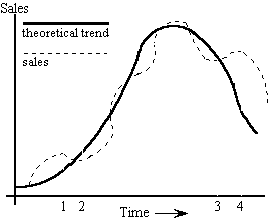The advantages of the product life cycle.
Written by Dave Collins, SoftwarePromotions Ltd.
https://www.softwarepromotions.com
Business is often associated with the dryer side of dullness, and many of us frequently refer with some distaste to “getting round to the business side of things”. But over the years some very useful methods and techniques have emerged from the “other-side”, many of which can be beneficial to all of us. After all, while we may consider much of what we do as a labour of love, we are nonetheless trying to make some money out of the whole thing as well! A good place to start is with the concept of the product life cycle.
Like most things, the sales (and demand) for your software conform to some sort of pattern. The advantages of the product life cycle concept is that it provides a basic structure that allows you to see where you are, and what lies ahead. There are four components to the cycle; introduction, growth, maturity and decline.
Introduce Your Product To The Market
The first component is fairly self-explanatory; when a new product is introduced, market gain tends to be very slight, and it is almost impossible to spot any kind of emerging patterns in demand. Depending on how you launch the software, marketing costs may be high, and it is unlikely that there are any profits as such. After the creation and subsequent release of your software, this often boils down to gritting your teeth and waiting. If this stage doesn’t lead into the next, then it may be time to jump ship.
The growth stage exhibits a rapid increase in both sales and profits, and this is the time to try and increase your product’s market share. By now you should be seeing where your demand is coming from, and which of your efforts are worth spending time and energy on. With a little bit of luck, you might even have knocked some of the competition out of the way too!
The growth stage is closely followed by the maturity stage, often seen as the “most common” stage for all products. Competition becomes more fierce and marketing becomes the key to your software’s success. During this time, any attempt to increase your market share will probably be expensive; growth at this stage is more likely to be down to external factors beyond your control.
Decline Doesn’t Equal Death
The final stage in the life cycle is the decline. This doesn’t necessarily mean that it’s time to abandon your product altogether, but rather that the introduction of new strategies might be in order. These could include new versions, new distribution methods, price reductions, in short anything that will inject a little life into the cycle.
Each of the four stages have their own characteristics, and each are open to different strategies being implemented. However, for many this stage will prove to be the critical one; many wait until this period before acting, and it is the only stage where some sort of action is critical. Two situations are frequently confused with a declining product. The product life cycle graphic below demonstrates the point.

Theoretically the product life-cycle is a smooth and elegant curve; in reality there are constant short-term fluctuations due to external factors. The first common mistake is to assume that any reduction in sales signals the onset of the decline phase. The area between points 1 and 2 may at first appear to be decline, but in fact are part of the growth stage. Similarly, the area between points 3 and 4 may at first be read as a new growth phase; in fact it is little more than a temporary increase that has no real significance.
Remember The External Factors
The advantages of the product life cycle concept speak for themselves. Once you’ve applied this model to your software, there are an unlimited number of options and strategies that may be implemented, according to the specifics of your software and its’ current stage in the life cycle. For example, you may wish to considering product life cycle acceleration strategies, or at the very least recognise where you are, and what lies ahead. Before responding to any of the stage characteristics, don’t forget to consider the external factors, particularly in response to the decline phase. My own favourite for analysing external factors is the PEST analysis; Political, Economic, Social and Technological – between them they pretty well cover the whole lot. Take all of this information into account before jumping to any conclusions.
As with all business ideas and theories, keep an open mind, be honest with yourself, and never rule out any option before thoroughly chewing it over. Professionalism and management techniques are not the sole prerogative of the big-boys; we can do far worse than picking-up a few of their better habits. The software industry is seen as amateur and unprofessional by far too many people; don’t start believing it yourself. Be seen, be sold.